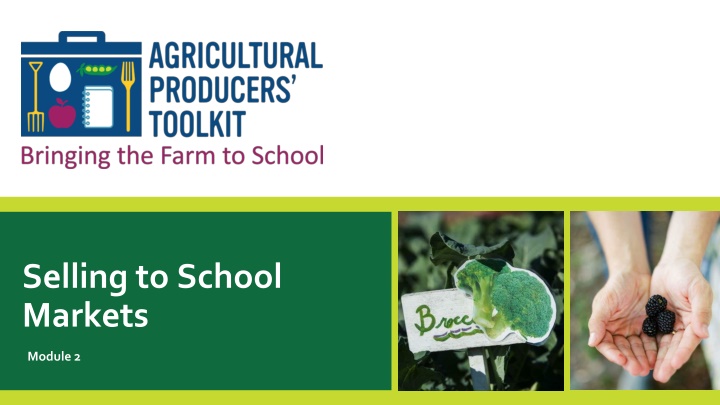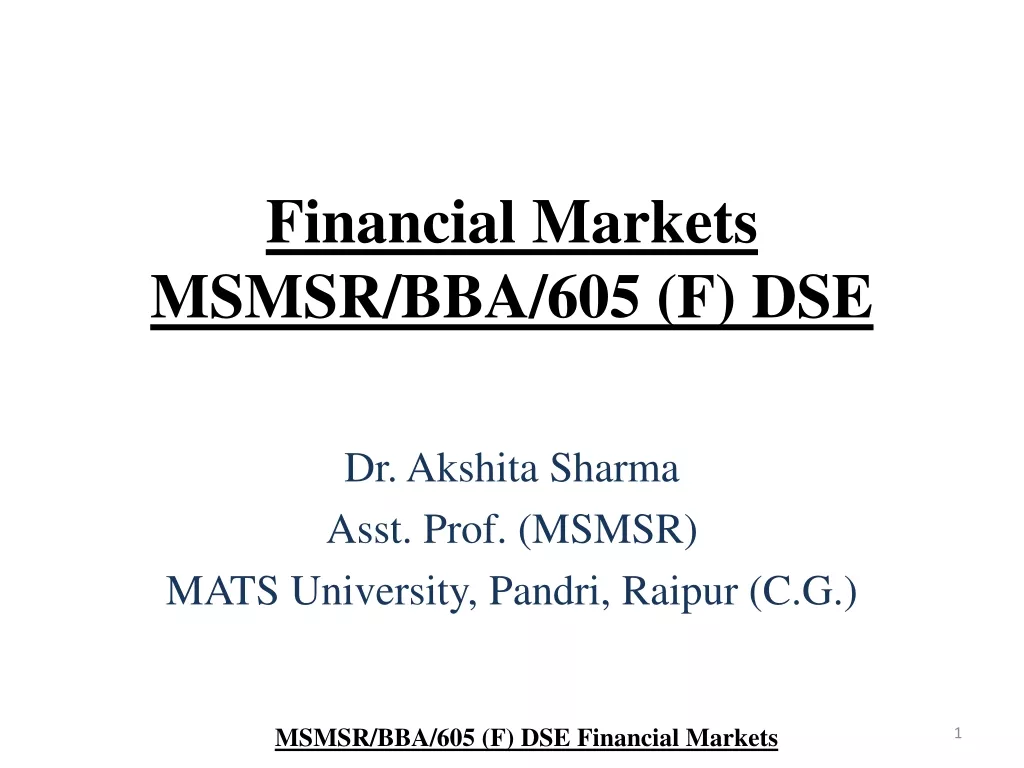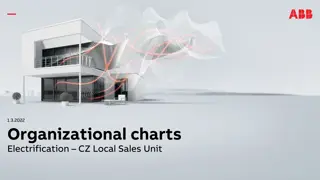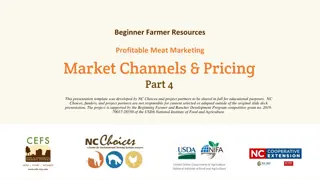Maximizing Sales in School Markets: Essential Strategies and Tools
Explore key modules on selling to school markets with a focus on identifying market channels, meeting vendor requirements, and communicating effectively with school buyers. Engage in interactive activities like Jeopardy to reinforce learning objectives. Understand the two primary supply chain models for reaching school markets - direct-to-school and intermediated. Learn about various market channels and how to get your products to schools through different avenues. Discover valuable insights and strategies for successfully selling to schools.
Download Presentation

Please find below an Image/Link to download the presentation.
The content on the website is provided AS IS for your information and personal use only. It may not be sold, licensed, or shared on other websites without obtaining consent from the author.If you encounter any issues during the download, it is possible that the publisher has removed the file from their server.
You are allowed to download the files provided on this website for personal or commercial use, subject to the condition that they are used lawfully. All files are the property of their respective owners.
The content on the website is provided AS IS for your information and personal use only. It may not be sold, licensed, or shared on other websites without obtaining consent from the author.
E N D
Presentation Transcript
Selling to School Markets Module 2
Learning Objectives Identify the best market channelsfor selling to schools, based on your operation s capacity and goals. Understand how to read and respond to a solicitation. Understand how to meet the vendor requirements of school markets. Understand how to meet the product-quality standards of school markets. Understand how to approach and communicate with school buyers. 2 Bringing the Farm to School: Agricultural Producers Toolkit
Applied Activity Let's Play Jeopardy Jeopardy is a great quiz game that can reinforce the key terms and concepts in each Farm to School training module. Questions and answers can be customized as farm-to- school trainers see fit for their producer workshops. The game can be created on black/white boards, notecards, utilizing online templates, or in PowerPoint by using hyperlinks (see How to Create a Power Point Jeopardy Quiz). Example Module 2: Getting to Know School Markets Vendor Requirements $100 $200 $300 $400 Market Channels School Buyers Quality Standards $100 $200 $300 $400 $100 $200 $300 $400 $100 $200 $300 $400 3 Bringing the Farm to School: Agricultural Producers Toolkit
Section A: Farm To School Market Channels
Overview of Farm to School Market Channels There are 2 primary supply chain models for getting your food into school markets: Direct-to-school Intermediated According to the USDA Farm to School Census, 63% of school districts that participate in farm to school use intermediaries, such as distributors 40% of schools report they get local food through a farmer directly 5 Bringing the Farm to School: Agricultural Producers Toolkit
How Does Your Product Get to the School? 6 Bringing the Farm to School: Agricultural Producers Toolkit
Intermediated Market Channels Local Retail Outlets Regional Aggregators and food hubs Value Added Processors Independent Local and Regional Distributors 7 Bringing the Farm to School: Agricultural Producers Toolkit
Selling to Schools Through Local Retail Outlets Photo: Unsplash 8 Bringing the Farm to School: Agricultural Producers Toolkit
Selling to Schools Through Food Hubs 9 Bringing the Farm to School: Agricultural Producers Toolkit
Applied Activity Exploring Food Hubs Credit: https://www.ams.usda.gov/local-food-directories/foodhubs 10 Bringing the Farm to School: Agricultural Producers Toolkit
Selling to Schools Through Regional Distributors Credit: https://amproduce.com/ 11 Bringing the Farm to School: Agricultural Producers Toolkit
Considerations for Selling to Schools Through Regional Distributors These channels can be a good match for producers familiar with wholesale practices Regional distributors do source from small and diversified farms Many distributors rely on established suppliers Important considerations include: Understanding of forward contracting Having a food safety plan and food safety certification Product quality and post-harvest handling Ability for providing computerized invoice and recordkeeping program Contingency plans 12 Bringing the Farm to School: Agricultural Producers Toolkit
National Wholesale Distribution Channels Broadline distributors Foodservice management companies USDA food distribution programs (eg, USDA Foods and DoD Fresh) 13 Bringing the Farm to School: Agricultural Producers Toolkit
Direct-to-School Supply Chains Direct-to-school supply chains are what many people think of first when they hear farm to school Photo: USDA a relationship directly between a local producer and the school. Photo: Unsplash 14 Bringing the Farm to School: Agricultural Producers Toolkit
Direct-to-School Buyers School buyers have many names, such as: School Food Authorities School Nutrition Directors School Foodservice Managers Procurement Managers Photo: USDA 15 Bringing the Farm to School: Agricultural Producers Toolkit
Direct-to-School Market Channels Farmers Markets & Farm Stands: Producers cansell directlyto schools through farmers market channelsthey may already beutilizing. Community Supported Agriculture: Schools may become a CSA drop site or offer a farm raiser School Contracts & Purchase Orders: Producers cansell directly to school districtsutilizing bothformal and informal procurement methods. 16 Bringing the Farm to School: Agricultural Producers Toolkit
Collective Purchasing Models Producers can potentially establishthemselves as anapproved supplier,so that they can access multiple school markets through a streamlined process, thereby: aggregating product demand increasing product volumes expanding school sales 17 Bringing the Farm to School: Agricultural Producers Toolkit
Direct-to-School: Potential Benefits High levels of customer satisfaction Allows you to retain and grow yourbrand & business Potential market for lower grade products Direct lines of communication Increased competitiveness in bidding processes Local decision-making processes Photo: USDA 18 Bringing the Farm to School: Agricultural Producers Toolkit
Direct-to-School: Potential Drawbacks Increased time spent marketing products Determining a fair price can be complex Minimum food safety standards Required documentation and recordkeeping Payment processes Vendor establishment Photo: USDA 19 Bringing the Farm to School: Agricultural Producers Toolkit
Choosing the Market Channel Mix That Works Best For You Photos: USDA 20 Bringing the Farm to School: Agricultural Producers Toolkit
"What's in a School Solicitation? Background Information Solicitations are how school districts communicate what products they're looking for.... when they need them... how much they need... and any requirements they have for potential vendors. Description of goods and services Procurement method Technical requirements Timeline Terms and conditions 22 Bringing the Farm to School: Agricultural Producers Toolkit
Accessing School District Solicitations 23 Bringing the Farm to School: Agricultural Producers Toolkit
Understanding Product Specifications Specifications describe product standards required to meet the needs of the school market you are seeking to sell to. They are not one-size fits all, but commonly include: Product & Variety: for example,heirloom/variety typical to the region Quality standards & size: for example,minimally processed foods and seconds Quantity & pack size: for example, wholesale pack sizes versus sales by unit. Photo: USDA 24 Bringing the Farm to School: Agricultural Producers Toolkit
Applied Activity Exploring Product Specifications 25 Bringing the Farm to School: Agricultural Producers Toolkit
Meeting Common School Vendor Requirements Common requirements for potential vendors seeking to sell to school markets include: Post-Harvest Handling Practices Food Safety Practices Insuranceand Licenses Distribution Logistics Photo: USDA 26 Bringing the Farm to School: Agricultural Producers Toolkit
Bringing it TogetherResponding to School Solicitations When responding to a solicitation remember to take the opportunity to stand out as a local vendor! To additionally differentiate yourself as a local vendor, you can offer to: host field trips or farm visits come in for classroom visits provide materials for cafeteria education support school community events 27 Bringing the Farm to School: Agricultural Producers Toolkit
Applied Activity Responding to School Solicitations 28 Bringing the Farm to School: Agricultural Producers Toolkit
Understanding What Motivates a School Nutrition Director You should make an opportunity to meet with the school food service director for the district to learn about their specific needs and requirements. Here are some key points to discuss together: Program Goals Product Needs Sourcing Practices and Preferences Solicitations and Procurement Payment Contingencies Do not assume that all schools will have the same motivations and requirements! 29 Bringing the Farm to School: Agricultural Producers Toolkit
Approaching School Nutrition Directors It is important to be patient when approaching with school food service directors, working directly with farmers may be as new to them as working with schools is to you! Here are a few things you can do to help jumpstart relationship building and build trust: Avoid judgment and don tshame school food Be prepared for you conversation Never show up unannounced Share your expertise (and passion!) Communication is key Remember, developing trusted relationships takes time 30 Bringing the Farm to School: Agricultural Producers Toolkit
Meeting with School Nutrition Directors 31 Bringing the Farm to School: Agricultural Producers Toolkit
Applied Activity Considerations for Selling to School Districts Photos: USDA 32 Bringing the Farm to School: Agricultural Producers Toolkit
Bringing the Farm to School Case Studies Case Studies Food hub Written case study + video: Food Connects (Vermont) Podcast: KC Food Hub and KC Farm School (Missouri) Video: Michigan Farm to Freezer (Michigan) DoD Fresh / distributor Swanson s Orchard and Grasmick Produce (Montana) Amazing Grace Family Farm (Wisconsin) Direct-to-school / state purchasing cooperative Anthony Young Farm (New Mexico) 34 Bringing the Farm to School: Agricultural Producers Toolkit
Action Planning Checking In I know how to access my local school market channel options. I know the basics of marketing relationships with distributors. I know how to find and respond to school solicitations. I know how to approach and communicate with school buyers. I know who to communicate with at the school district. I understand common school purchasing practices and vendor requirements. I understand how schools expect to receive local products- quality management and post-harvest handling practices. 35 Bringing the Farm to School: Agricultural Producers Toolkit
The Bringing the Farm to School: Agricultural Producers Toolkit was developed in partnership by USDA Food and Nutrition Services, the National Center for Appropriate Technology, and the National Farm to School Network. Click to enter Facilitator s Name Click to enter Facilitator s Title Phone: (XXX) XXX-XXXX Email: www.xxxxxx.com























